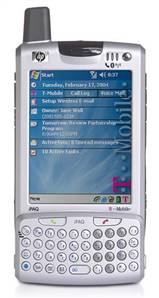




| 2004-December-27 China officially launched Cernet2 high-speed Internet backbone, the world largest next-generation network based solely on Internet Protocol Version 6 (IPv6) technology. It connects 25 universities in 20 cities, and is expected to expand to cover another 75 universities. In December 7 trial on CERNET2 between the Chinese capital Beijing and Tianjin reached a sustained speed of 40 gigabits per second, setting a record for real-world applications, where the average speeds are less than 10 Gbps for universities. The driving force behind the push to IPv6 network is address space. According to China Education and Research Network (CERN), the U.S. controls 74 percent of the 4 billion IP addresses possible with IPv4, with China limited to the same number of IP addresses as the University of California, despite its 80 million Internet users. With 128-bit addresses, IPv6 can support upto 34,028,236,692,093,846,346,337,461 trillion addresses. Asian countries and companies, including Fujitsu, Hitachi, NEC and Samsung, have collaborated on the transition from today's IPv4 Internet to IPv6. The consortium, under pressure to head off a shortage of IPv4 addresses, has indicated the newer technology might be mandated beginning next year. Work toward IPv6 in the U.S. has involved the Department of Defense, Cisco, IBM, Microsoft, HP and others, but the continued availability of IPv4 addresses has resulted in a lack of urgency.
2004-December-7 Trend Micro, late comer in the mobile computing scene, announced that it will offer its PDA version of anti-virus and anti-spam security software for free until June 2005. Currently only available for Microsoft Windows Mobile 2003, Trend Micro will start supporting Symbian next year. Although only Skull and Cabir viruses had affected handhelds this year, Trend Micro believes it is only a matter of time before hackers tart targeting handhelds for malicious purposes.
2004-December-4 IBM, the world third largest PC maker, is seeking to sell its PC business for USD 1 billion to USD 2 billion. The buyer would also be able to gain access to the blueprints of IBM's ThinkPad, a family of laptops generally regarded as the world's most reliable and secure laptops. Potential buyers include China's Lenovo, who is seeking a rapid expansion into world market by leveraging its cheap labour cost. UPDATE DEC-8 : Lenovo annouced that it will will pay $1.25 billion for the IBM PC unit and assume debt, IBM will keep 18.9 percent stake in Lenovo.
2004-November-25 Microsoft unveiled a new Windows XP Counterfeit Project in the United Kingdom. Under the program, anyone who suspect that their Windows XP software may not be legitimate can send it in for analysis. Software found to be counterfeit will be replaced for free. The deal only covers Windows XP, and only five copies per person can be swapped. The offer only applies to pre-installed home or professional Windows XP bought before Nov. 1 and with a proof of purchase. Alex Hilton, Microsoft's license compliance manager, said the bulk of piracy seen by Microsoft was in the OEM (original equipment manufacturer) sector. The U.K. has an estimated software piracy rate of about 29 percent. If successful, the program could be introduced in other countries.
2004-November-10 Firefox 1.0 is now available for download. This is free browser that's based on the open-source Mozilla code, and is in many ways better than Internet Explorer.
2004-November-8 IBM's Blue Gene/L super computer is now availble for sale by IBM's server group under the brand name eServer Blue Gene. IBM is selling it in configurations ranging from one to 64 racks; each rack has 1,024 processors and costs USD1.5 million. A fully configured Blue Gene will have 65,636 processors and can achieve a theoretical maximum of 360 Teraflops. In comparison, the current fastest super computer on record is officially the Japanese Earth Simulator, which can sustain 35.86 Teraflops with its 5,120 processors. IBM made the annoucement a week after NASA annouced that its Columbia system built by SGI had reached 42.7 Teraflops using 10,240 processors. The current unfinished Blue Gene installed at the Lawrence Livermore National Laboratory has achieved a sustained performance of 70.72 TFlopswith its 16 racks of 16,384 processors.
2004-November-1 TMNet has upgraded its RM88/99 Streamyx package to 1Mbps/384kbps downstream/upstream speed. In anticipation of that move, we had also upgraded our primary line to 1.5Mbps/1.5Mbps over the weekend. This is to allow all our users to take full advantage of the higher bandwidth.
2004-November-1 Intel will launch its new Pentium 4 Extreme Editition together with the new 925XE Express supporting chipset on November 15. Most notable of all is the increased system bus speed from 800MHz to 1066MHz, requiring 533 MHz DDR RAM to take full advantage of the 33% increase in raw speed.
2004-October-20 Advanced Micro Devices (AMD) annouced the Athlon 64 FX-55 and the Athlon 64 4000+ processors, only days after Intel said it would scrap plans to build 4.0 GHz Pentium 4 processor. The 2.6GHz FX-55 chip is equipped with 1MB of L2 cache, while the 4000+ is clocked to operate at 2.4GHz (AMD's model numbering scheme would indicate that the 4000+ performance is roughly equivalent to a normal Intel 4.0HGz Pentium 4). Intel, on the other hand, said it would increase performance of its 3.8 Hz Pentium 4 Extreme Edition by increasing the amount of memory cache on chip from 1MB to 2MB. One strategy that is the same for both companies is that they are investing heavily in dual core processor design, expected to be widely available next year. Microsoft had annouced that it would treat these new multi-core processors as a single processor for its software product. The company said this is in line with its policy of licensing by physical processors.
2004-October-14 IBM announced two additions to its family of high storage products. The IBM TotalStorage DS6000 is about the size of an Astro set top box, can store between 580 gigabytes to 67.2 terabytes (67,000 gigabytes) of data with prices starting at USD97,000, the DS8000 can store upto 450 petabytes (450,000,000 gigabytes) of data with prices starting at USD250,000. Both products are expected to be available in December.
2004-October-4 The T5 has a 320-by-480-resolution color screen that can display documents, images, and videos in either landscape or portrait mode. The built-in viewer supports viewing of Microsoft Word, Excel or PowerPoint documents. Tungsten T5 handheld will cost USD399 when it becomes widely available worldwide in November.
2004-October-1 IBM announced that it has built the world fastest super computer using 16,000 processors. The IBM Blue Gene/L super computer sustained performance of 36.01 trillion calculations a second, or teraflops, slightly faster than NEC's Earth Simulator in Yokohama. IBM's new system is 99% smaller than NEC's Earth Simulator, and consumes 96% less energy. When the Japanese Earth Simulator achieved 35.86 in 2002 and took the position of the world's fastest super computer, United States government officials were deeply concerened. Supercomputing technologies were widely viewed as indicators of national industrial prowess as they were used extensively in weapons design and high-tech industries ranging from biotechnology to materials science. A large-capacity version of the Blue Gene/L system is scheduled to be installed early next year at the Lawrence Livermore National Laboratory in Livermore, California. That machine will have about 130,000 processors, compared to the 16,000-processor prototype that set the current speed record.
2004-September-23 Ireland is moving to block direct international call (IDD) to 13 countries to protect its Internet users from an Internet scam. The scam involved luring users to download a self-install dialer program. Instead of dialing the local ISP numbers (for example, 1511 for Jaring, 1515 for TMNet), the dialer makes an international call and access the Internet via a foreign ISP, resulting in exorbitant phone bills at the end of the month.
2004-September-13 TMNet is now attempting to track down the computers that were used for hacking into its user database. It will affect some services and network performance will be slow from now till 17 September. If you are TMNet user, you WILL encounter intermittent problems until then. Please read the following announcement from TMNet.
2004-September-8 TMNet is experiencing problem with its Internet backbone, which affects all Malaysian Internet users. The problem started from Penang at around 8:30AM, and rippled down to JB by around 9:30AM. All users will experience intermitten connectivity problem. As our Internet connectivity is provided by Telekom (TMNet), we are affected by this interruption as well. We are working with TMNet to resolve this issue. All our application services are temporarily running at 1/3 the capacity. UPDATE SEP-10 : All our net services are back to normal and have stablized. The problem originated from within TMNet where their user database were hacked into and some of the passwords were changed.
2004-September-4 Unlike iPod, Portable Media Center is an entirely new category of handheld devices designed to playback digital music, TV, movies, and pictures. Samsung's Yepp YH-999 20 GB and Creative Labs's 20 GB Zen will be available at around USD500. 20GB is enough to store 80 hours of video, 5,000 songs, and tens of thousands of pictures.
2004-August-27 Notebook PCs equipped with Intel's new 2915ABG chipset for its Centrino platform will support tri-mode wireless connection. The device will support the 802.11a, b, and g wireless standards. The 802.11b standard supports data speeds of up to 11 Mbps in the 2.4-GHz band; 802.11g can handle 54 Mbps over the 2.4-GHz band; 802.11a transmits data at 54 Mbps in the 5-GHz band. For security, the chipset will support the IEEE 802.11i standard.
2004-August-11 Some of our PCs will be pre-installed with Windows XP Starter Edition, which will cost about RM400 less than PCs with Windows XP Professional Edition. Note that Windows XP Starter Edition in Malaysia will run in Bahasa Malaysia only. For further details, please call or email us.
2004-August-10 The monitor uses two LCD panels, one in front of the other. The front panel displays the image. The back one angles the light coming from the backlight, sending alternate columns to the left and right eyes. In 2D mode, the rear panel simply shuts off so that all pixels are seen by both eyes. Light from the LCD is divided so that different images reach the viewer's left and right eyes. When centered in front of the display, each eye receives the correct visual information for the brain to process. This makes it possible for the image on the screen to appear in three dimensions without the user having to wear special goggles. The LCD is available now at USD1499 each.
2004-August-9 Microsoft Windows XP Service Pack 2 can now be downloaded by selected developers; and will be made available to the general audience within a week. The update is 475MB, which can either be downloaded from Microsoft's download centre, or ordered via CD.
2004-August-2 Intel announced the immediate availability of its new Xeon processor, code-named 'Nocona'. Nocona is bascially Xeon with more cache, faster front-side bus, 64-bit extension. Together with Intel's new chipset 'Lindenhurst', Nocona-based servers can address upto 1 Terabyte of memory; that's 256 times of Xeon's maximum 4 Gigabytes, or 4096 times of a typical desktop's 256 Megabytes RAM. Note that the Nocona is not a 64-bit processor. Intel believes that this architecture is only a placeholder for the transition to true 64-bit operating systems and applications.
2004-July-27 The convergent of mobile phone and personal digital assistant (PDA) continues.
HP introduces a new suite of HP iPAQ handheld devices. Most notably being its new new top-of-the-line iPAQ Pocket PC H6315, the first Pocket PC to integrate cellular, 802.11b Wi-Fi, and Bluetooth capability. The H6315 has a built-in camera with a digital zoom lens that can capture 640-by-480 images, a snap-on thumb keyboard and a charging cradle with an extra slot for recharging an optional additional USD50 standard or USD100 extended-life removable battery. Depending on your usage patterns, HP says the H6315 should run a day or two on a standard battery, twice as long with the extended battery. It measures 4.7 by 3 by 0.7 inches and weighs 6.7 ounces. The screen is HP's 3.5 inch color model. Inside is a Texas Instruments OMAP 1510 processor. There’s 64 MB of ROM and 64 MB of RAM. It runs on Microsoft Windows Mobile 2003 for Pocket PC - Phone Edition.
2004-July-13 The release date of Windows XP Service Pack 2 has been pushed back To August 2004. The final size of Service Pack 2 may be larger than 200 Gigabytes. The most anticipated new features offered by Windows XP SP2 are its security enhancements to better protect users while on-line.
2004-July-8 A survey conducted by research firm International Data Corp. for the Business Software Alliance (BSA), showed that 36 percent of the software installed on computers worldwide in 2003 was pirated, representing a loss of about 29 billion dollars to companies. Last year, the BSA said the piracy rate was 39 percent, down from 40 percent in 2002. The study found that while 80 billion dollars' worth of software was installed on computers worldwide last year, only 51 billion dollars' worth was legally purchased. In dollar vale, the losses were greatest in the United States (6.5 billion dollars), followed by China (3.8 billion), France (2.3 billion), Germany (1.9 billion), Japan (1.6 billion) and Britain (1.6 billion).
|
|
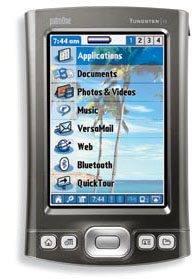 PalmOne launched the Tungsten T5, its top-of-the-line unconnected handheld. At 121 x 96.5 x 15.5 mm and 144 grams, it uses Intel's 416-MHz Bulverde CPU for handhelds and comes with 256MB
(215MB user available)
of memory, a built-in Bluetooth adapter, and can operate as a USB Flash drive.
PalmOne launched the Tungsten T5, its top-of-the-line unconnected handheld. At 121 x 96.5 x 15.5 mm and 144 grams, it uses Intel's 416-MHz Bulverde CPU for handhelds and comes with 256MB
(215MB user available)
of memory, a built-in Bluetooth adapter, and can operate as a USB Flash drive. 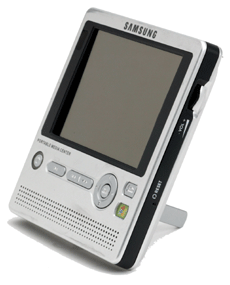 Microsoft releases Windows Media Player 10, MSN Music preview, and Portable Media Center devices to compete with
Apple and HP with their iPod devices.
Microsoft releases Windows Media Player 10, MSN Music preview, and Portable Media Center devices to compete with
Apple and HP with their iPod devices.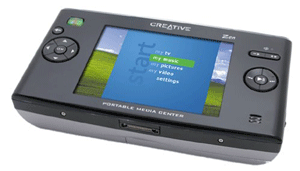 Microsoft said that on average, the transfer from the PC to the Portable Media Center using Auto Sync, a new feature of Windows Media Player 10, will take less than 60 seconds for a 30-minute clip and less than three minutes for a two-hour movie. The content from these online services is protected by Windows Media Digital Rights Management (DRM) 10.
Microsoft said that on average, the transfer from the PC to the Portable Media Center using Auto Sync, a new feature of Windows Media Player 10, will take less than 60 seconds for a 30-minute clip and less than three minutes for a two-hour movie. The content from these online services is protected by Windows Media Digital Rights Management (DRM) 10.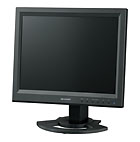 Sharp's new LL-151-3D flat-panel display
uses a parallax barrier to display video in three dimensional graphics.
Sharp's new LL-151-3D flat-panel display
uses a parallax barrier to display video in three dimensional graphics.
